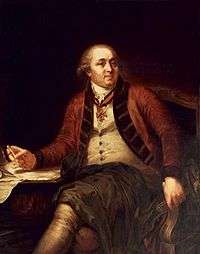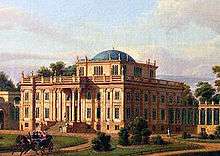Ivan Starov

Ivan Yegorovich Starov (Russian: Ива́н Его́рович Старо́в) (February 23, 1745, in Saint Petersburg – April 17, 1808, in Saint Petersburg) was a Russian architect from St. Petersburg who devised the master plans for Yaroslavl, Voronezh, Pskov, Dnipropetrovsk, Mykolaiv, and many other towns in Russia and Ukraine. His radial urban master plan for Yaroslavl (1778), cleverly highlighting dozens historic churches and towers, is recognized as one of the World Heritage Sites.
Starov was one of the first graduates of the Moscow University College (1755–1758) and of the Imperial Academy of Arts (1758–1762). He continued his education in Paris (1762–1767) and Rome (1767–1768), becoming apprenticed to Charles De Wailly and other fashionable architects of his day. Back in Russia, he delivered lectures in the Academy of Arts, which nominated him academician (1769) and professor (1785). Starov held the post of the principal architect of St. Petersburg between 1772 and 1774. After that, he worked extensively for Prince Potemkin, helping him to found the major cities of New Russia.
Works
Apart from urban planning, Starov was a leading representative of the early neoclassical architecture in Russia. His major projects chronicle the transition of national architecture from the late Rinaldiesque baroque of the 1760s to the magnificent Neoclassical palaces of the 1780s:

.jpg)
- 1769—Demidov dacha near Peterhof, commissioned by Starov's brother-in-law, Alexander Demidov, and destroyed by the Nazis.
- 1773—chateau and church in Bogoroditsk, commissioned by Count Bobrinsky.
- 1773—chateau and church in Nikolskoye near Moscow, commissioned by Prince Gagarin.
- 1774—chateau, gothic gate and park in Taytsy near Gatchina, commissioned by Alexander Demidov.
- 1775—chateau and park pavilions in Suvoritsy near St. Petersburg, commissioned by Pyotr Demidov.
- 1778—Trinity Cathedral of the Alexander Nevsky Lavra in St. Petersburg, commissioned by the Holy Synod.
- 1783—gate church and iron-cast grille of the Alexander Nevsky Lavra, commissioned by the Holy Synod.
- 1783—Tauride Palace in St. Petersburg, commissioned by Prince Potemkin.
- 1783—chateau in Ostrovki on the Neva River, commissioned by Prince Potemkin, currently in ruins from neglect.
- 1784—Pella Palace on the Neva River, commissioned by Catherine II of Russia and demolished by her son Paul.
- 1784—Lithuanian prison castle at the intersection of the Moyka and the Kryukov Canal in St. Petersburg, demolished after the 1917 fire.
- 1786—Potemkin Palace in Yekaterinoslav, commissioned by Prince Potemkin.
- 1789—Prince Vladimir Church, Saint Petersburg, completed
- 1790—Potemkin mansion in Bogoyavlensk-on-the-Bug, commissioned by Prince Potemkin.
- 1790—magistrate and cathedral in Mykolaiv, commissioned by Prince Potemkin.
- 1794—chateau and pavilions in Voznesenskoye on the Neva River, commissioned by Count Sheremetyev.
- 1795—Potemkin mausoleum, commissioned by Potemkin's niece Countess Branicka but never executed.
- 1796—Theotokos Cathedral in Kazan, commissioned by the Kazan Governorate and destroyed by the Communists.
The Kherson Cathedral in Ukraine and the Homel Palace in Belarus are also frequently attributed to Starov.
External links
| Wikimedia Commons has media related to Ivan Starov. |
- Ivan Starov: life and works (in Russian)